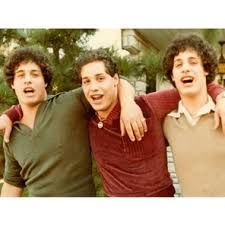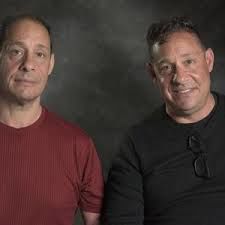
Psychiatry
A Hit Documentary Exposes Psychiatry's Past Failures
Three Identical Strangers takes a surprising left turn.
Posted September 19, 2018

The documentary Three Identical Strangers by filmmaker Tim Wardle takes us (spoiler alert!) from fun and frothy to a surprising left turn about the evils of human experimentation. The film raises moral questions that lead us, unsuspectingly, to a very dark place.
When Bobby Shafran went off to college at age 19, he was greeted by fellow students as if he were an old friend. But they called him Eddy. One of these friends realized that Bobby had the same birthday as Eddy Galland, his lookalike, and both had been adopted. Eddy had been at the school the previous year and did not return. Bobby and Eddy met and bonded instantly. They clearly were twins, separated at birth.
After a newspaper article was published about them, a third brother, David Kellman, saw his likeness, and then there were three. They were on all of the talk shows exhibiting their amazing physical resemblance. All were 5' 9", with thick, curly brown hair and dark complexions. They talked and laughed alike, had identical birthmarks, identical IQs of 146, and even lost their virginity at 12. The triplets discovered that they all smoked too many Marlboros, preferred Italian food despite being raised in Jewish homes, and liked older women.
Soon they moved in together and opened a restaurant called Triplets. All three married, and then the initial similarities, apparent nature over nurture, proved very superficial. Bobby, who was the moody one, left the business and went on to become a lawyer. Eddy, who was outgoing, emotional, and bigger than life, didn't cope well. He got hospitalized and diagnosed with manic depression. I have no idea if this diagnosis was even accurate. He committed suicide at age 33. David closed the restaurant and sold insurance.
There were significant major emotional issues for each of them in adolescence. Eddy, for example, took part in a robbery where an 83-year-old woman was beaten to death with a crowbar. His role was minimal and he testified against his accomplice. He received no jail time and changed schools to start a new life.
An Experiment in Cruelty
No, the story did not end here. What really happened? This is exactly what investigative journalist, Lawrence Wright, decided to discover. And he did.
It turned out that eminent psychoanalyst Peter Neubauer, from Manhattan's Child Development Center in New York City, established in 1947, had set up a long-term study to have twins be separated at birth and adopted, on purpose, presumably to evaluate nature vs. nurture.
He worked with the Louise Wise adoption agency, the most prestigious Jewish adoption center in New York. Teams of researchers filmed and interviewed the boys, and other twins, under false pretenses for years. The adoption agency was supposed to be caring for the well-being of these children. Given this responsibility, they never should have considered separating any of the twins. All efforts should have been made to keep families together. Instead, they joined this self-aggrandizing study and kept it all a secret. They even camouflaged it further by using families that had already adopted an older sister in order to study the families. One "subject" each was placed in a well-to-do family, a middle-class family, and a poor family. In one scene of the film, the adoptive parents demand a meeting with the agency to find out what is going on. Footage shows the agency celebrating with champagne because the secret study did not get discovered.
Wright also learned that the biological mother of the triplets was diagnosed with schizophrenia. Was this also a study to trace whether this was an inherited attribute? The biological mothers of other twins had schizophrenia as well. Neubauer wouldn't talk to the filmmakers. After he died, the study was sealed and sent to Yale University, not to be opened until 2065. No results were ever published. A very redacted version of the study was recently released to the surviving brothers, with very little information.
Repeating Psychiatric History's Mistakes
The purpose of psychiatry is to treat the suffering of patients. The source of emotional pain is derived from how our "nature" fields and digests our "nurture." Our personalities are formed as a result of the specific experiences and intricacies of our lives.
Yes, twinhood is fascinating. The truth is that anyone who knows identical twins well also knows that they have very different temperaments. Each twin is a unique individual, as we all are, despite their physical resemblance. This has always been known. Genetic knowledge 60 years ago wasn't as sophisticated as it is today. But the presumption that twins are the gold standard for genetic testing has always been iffy. Today, this has been discredited between the issue of different copy number variations in each twin, which compose 30 percent of the genome, and epigenetics, where the unquantifiable complexity of the external environment deeply affects conditions in the womb for the transcription of genes.
These three boys were purposely separated from their bonds of connection with each other in the name of science. This never should have happened. The film shows footage of them raging in their cribs, unable to sleep after the separation. They could have easily been kept together and raised as brothers; one of the fathers said he would have taken all three. This was a family, which is sacred.
Even more incredible is that the entire cast of characters in this story were Jewish. The study took place less than a generation after the concentration camps and the horrendous, sickening "twin" studies promulgated by the angel of death, Dr Mengele. Talk about identifying with the aggressor. How could this happen, all in the name of science? This wasn't as egregious as the Nazi experiments. Nonetheless, no one has the right to break up families and study the individuals "like rats in a cage." These experiments were performed illegally, without the informed consent and knowledge of the test subjects or their extended families. The lives of these three boys and the others were deeply and irrevocably affected and changed.
Psychiatry has its own history of corruption and destructive practices, and has been complicit in human experimentation, sterilization, and other inhumane so-called treatments. Eugenics was a deeply held belief among many psychiatrists until the 1950s. In the United States, 65,000 patients with schizophrenia were sterilized. In the 1930s, the Nazi sterilization and euthanasia plans were greatly influenced by policies in the state of California. The Rockefeller Foundation actually funded Mengele's research before he took it to the next level in Auschwitz. In 1942, there was a debate in the American Journal of Psychiatry about whether or not to kill "feeble-minded" patients. This was taken very seriously. We lobotomized 20,000 people in the United States. We're still doing an increasing number of shock treatments in 2018.
The documentary reveals the dark side of psychiatry. All but two of the many responsible researchers refused to be in the film. Natasha Josefowitz, Neubauer's chief research assistant, says in the film, "In the late 1950s, this was not something that seemed to be bad." She quickly showed herself to be a self-promoting narcissist. Yes, it was destructive. Nothing was learned, nor could be.
A warm and compassionate aunt commented that there was never a need for any study. You just had to spend time with the boys to know they were all very different individuals. Through her common sense she knew each young man was uniquely himself.
Human experimentation is wrong and immoral. What matters in raising children is for them to be well enough loved and cared for. This is the source of our humanity. Eddy, as it turned out, wasn't. He was subject to a strict disciplinarian. The aunt is absolutely correct. Altering the triplets' lives this way was wrong, immoral, and unnecessary. It was more about fostering the careers of the scientists involved. The boys were biologically brothers but they weren't brothers. They should have been. They, sadly, were "identical strangers."




